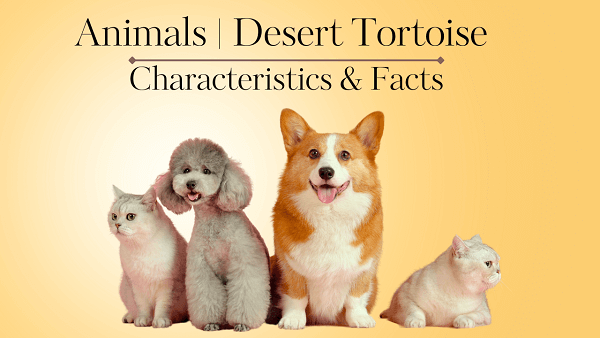
Desert tortoise Definition | Characteristics & Facts
Desert Tortoise Definition
It belongs to the species of tortoise native to the southwestern United States and northwestern Mexico. It is a reptile known for its adaptation to desert environments.
Desert Tortoise General Characteristics & Facts
Size and Appearance
The desert tortoise is a medium-sized tortoise species. On average, adults measure between 9 to 15 inches (23 to 38 centimeters) in length. They have a round, domed shell with a bumpy texture. The shell coloration can vary, ranging from brown to dark brown or black, which helps them blend into their desert surroundings.
Adaptations for Desert Life
Desert tortoises possess several adaptations that enable them to thrive in arid environments. They have thick, scaly skin to minimize water loss and can store water in their bladder, allowing them to survive in drought conditions. Their ability to dig burrows helps them escape extreme temperatures and seek shelter.
Long Lifespan
Desert tortoises have a long lifespan, often exceeding 50 years in the wild. Some individuals have been recorded to live up to 80 years or more.
Herbivorous Diet
The desert tortoise is primarily herbivorous, feeding on a variety of vegetation. Their diet consists of desert plants, grasses, leafy greens, flowers, and cacti. They play an essential role in maintaining the balance of plant populations in their ecosystems.
Threatened Status
The desert tortoise is listed as a threatened species under the U.S. Endangered Species Act. Habitat loss, fragmentation, disease, and predation are among the major threats to their population. Conservation efforts focus on protecting their habitat and managing populations to ensure their survival.
Reproductive Habits
Desert tortoises have a slow reproductive rate. Females lay a small clutch of 1 to 8 eggs in a nest dug in sandy soil. The eggs incubate for about 80 to 120 days, and the hatchlings emerge in late summer or early fall.
Hibernation
Desert tortoises undergo a period of dormancy known as brumation. During the colder months, they retreat to their burrows and enter a state of reduced activity to conserve energy. Brumation helps them survive the winter when food resources are scarce.
Symbol of the Desert
The desert tortoise is an iconic species of arid ecosystems and is considered a symbol of the desert. It holds cultural and ecological significance in its native range.
Physical Characteristics of Desert Tortoise
- Shell: The desert tortoise has a high, domed shell that serves as protection for its body. The shell, called a carapace, is composed of fused bony plates called scutes. It is typically brown to dark brown or black in color, helping it blend into its desert surroundings. The shell is hard and durable, providing defense against predators.
- Size: Adult desert tortoises can reach a length of about 9 to 15 inches (23 to 38 centimeters) and weigh between 8 to 15 pounds (3.6 to 6.8 kilograms). Males are generally larger than females.
- Limbs: The desert tortoise has sturdy, elephantine hind limbs and forelimbs adapted for digging and walking on uneven desert terrain. Their legs are short and strong, with sharp claws that aid in digging burrows.
- Skin: The skin of the desert tortoise is thick and scaly, helping to minimize water loss in the arid desert environment. The skin color can vary but is often brown or gray, providing camouflage.
- Head and Neck: The desert tortoise has a relatively small head compared to its body size. The head is covered in scales, and it houses the tortoise's eyes, nostrils, and a beak-like mouth. The neck is short and thick.
- Forelegs and Feet: The forelegs of the desert tortoise have powerful muscles and sharp claws that enable them to dig burrows for shelter. The feet are flattened with thick, padded soles that aid in walking on sandy or rocky terrain.
- Tail: The desert tortoise has a short and stocky tail. The tail is not prehensile but serves as a fat storage reserve, providing energy during periods of limited food availability.
Continue To Explore All Animals That Start With D
Scientific Classification of Desert Tortoise
Kingdom: Animalia (Animals)
Phylum: Chordata (Chordates)
Class: Reptilia (Reptiles)
Order: Testudines (Turtles and Tortoises)
Family: Testudinidae (Tortoises)
Genus: Gopherus
Species: Gopherus agassizii
Key Locations of Desert Tortoise
- United States (Mojave Desert region)
- Mexico (Sonoran Desert region)
- California (Coachella Valley)
- Arizona
- Nevada
- Utah
- Sonora
- Sinaloa
- Baja California
- Baja California Sur
- New Mexico
- Texas
- Nevada
- Colorado
- Utah
- Arizona
- Sonora
- Sinaloa
- Baja California
- Baja California Sur
View All A-Z Animals List
Desert Tortoise FAQs
What does the Desert tortoise eat?
- Grasses
- Wildflowers
- Cacti
- Shrubs
- Leaves
- Fruits
- Flowers
- Herbs
- Some succulents
- Opuntia cactus pads (prickly pear)
- Brittlebush
- Mojave yucca
- Creosote bush
- Desert dandelion
- Desert marigold
- Buckhorn cholla
- Barrel cactus fruit
- Joshua tree leaves and flowers
- Desert globemallow
- Ocotillo leaves and flowers





2 Comments
Great job on this post! The content is incredibly educational and meticulously
investigated, providing valuable insights into the topic at
hand. The style of writing is captivating and progresses seamlessly, making it an pleasurable article.
I value the effort put into communicating complex ideas in a
concise and concise. This post has certainly expanded my awareness
on the topic. Well done to the writer for delivering such a excellent piece!
I must say, this article surpassed my anticipations!
The depth of examination and the original perspective provided really sets it
apart. The writer's command of the subject is apparent, making complex concepts easily understandable.
The writing style is engaging and grabs the reader's interest from the very beginning.
I found myself absorbed in the content, enthusiastically absorbing every word.
This is a laudable piece of work that deserves acknowledgment.
Well done!